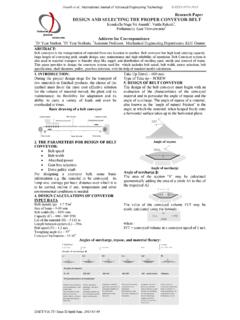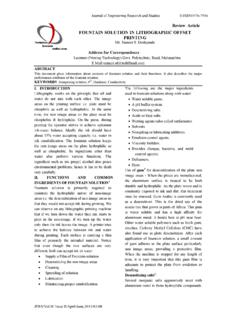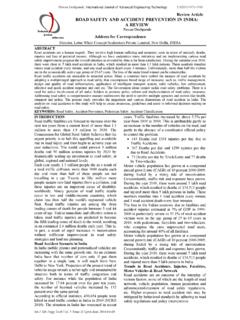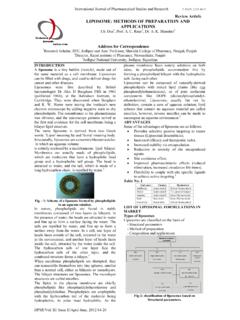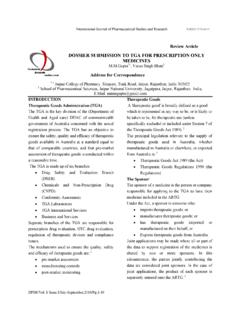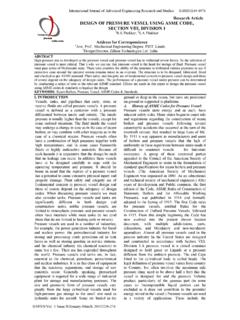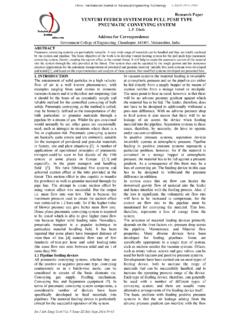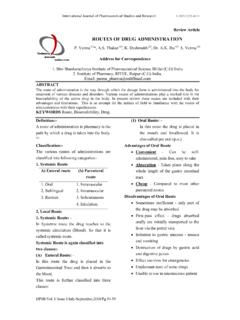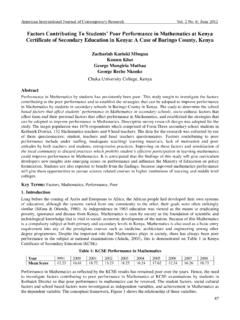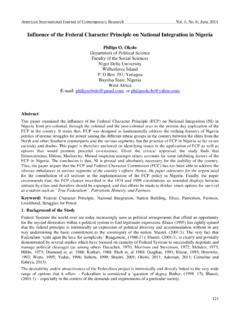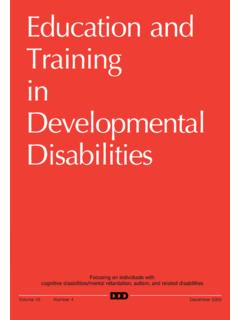Transcription of DEVELOPMENT DIFFERENT OILS - Technical Journals Online
1 International journal of Pharmaceutical Studies and Research E-ISSN 2229-4619 IJPSR/Vol. II/ Issue II/April- june , 2011 /45-51 Research Article DEVELOPMENT OF STABLE O/W EMULSIONS OF THREE DIFFERENT OILS Mostafa Shahin 1,5 ; Seham Abdel Hady 2 ; Mohammed Hammad 3; Nahed Mortada 4 Address for Correspondence 1 Department of Drug Technology, Faculty of Pharmacy and Pharmaceutical Sciences, Ain Shams University, Cairo, Egypt. 2 Department of Pharmaceutics, Faculty of Pharmacy, King Abdul Aziz University, Geddah, Kingdom of Saudi Arabia. 3 Department of Pharmaceutics, Faculty of Pharmacy, Zagazig University, Zagazig, Egypt 4 Department of Pharmaceutics, Faculty of Pharmacy and Pharmaceutical Sciences, Ain Shams University, Cairo, Egypt.
2 5 Corresponding author current address: Faculty of Pharmacy and Pharmaceutical Sciences, University of Alberta, Edmonton, Alberta T6G 2N8, Canada. E-mail address: ABSTRACT This study describes the formulation of DIFFERENT stable plain o/w emulsions containing several oils (jojoba oil, liquid paraffin and isopropyl myristate) with variable oil contents (20%, 30% and 40% w/w ) together with several surfactant blends ( Span 60, Span 83, Span 80, Myrj 53, Brij 35 and Tween 80). In the first place, the required hydrophilic lipophilic balance (RHLB) for jojoba oil was determined based on three DIFFERENT methods including the assessment of the degree of creaming after centrifugation and after shelf storage for 28 days at room temperature and the turbidimetric method. While the RHLB of liquid paraffin and isopropyl myristate were taken from the literatures. As such RHLB for jojoba was found to be On the other hand, the proper non ionic surfactant type was selected by the use of two methods, namely: the degree of creaming after 28 days shelf storage at room temperature and the turbidimetric method.
3 Results revealed that a blend of span 60 and brij 35 gave the most stable emulsion for all oils used. Finally, the most suitable emulsifier concentration for each oil type and level was determined using the turbidimetric method. Nine formulae were obtained that could used for variety of purposes. KEY WORDS O/W emulsion, jojoba oil, isopropyl myristate, heavy liquid paraffin, emulsion physical stability, turbidimetric method. INTRODUCTION Emulsions are the basis of a wide variety of natural and manufactured materials, including foods, pharmaceuticals, biological fluids, agrochemicals, petrochemicals, cosmetics and explosives [1-3]. Stable emulsions represent an effective approach for the resolution of problems in drug and cosmetic agents delivery. The emulsion stability have been studied extensively by many research groups and various methods of determining the emulsion stability have been proposed such as droplet size analyses [4], measuring physical properties of emulsion [5], accelerated tests [6], and light-scattering [7].
4 Among these methods, the most common are assessment of physical properties after centrifugation and shelf storage, which are time-consuming procedures. Turbidity measurements were also used to determine emulsion stability and they provide a faster approach to evaluate emulsion stability. In this work, we aimed at preparing stable o/w emulsions using DIFFERENT oily phases, namely: liquid paraffin, jojoba oil, and isopropyl myristate. At the same time we evaluated the effect of many formulation variables like, the effect of emulsifier type and emulsifier concentration as well as oily phase content on emulsion stability. MATERIALS AND METHODS Jojoba oil was purchased from Egyptian Natural Oil Company (Cairo, Egypt). Isopropyl myristate, sorbitan sequioleate (Span 83), polyoxyethylene23 lauryl ether (Brij 35), polyoxyethylene 50 monostearate (Myrj53), polyoxyethylene 20 sorbitan monooleate (Tween80), sorbitan monostearate (Span60) and sorbitan monooleate (Span80) were obtained from Sigma Chemical Company (USA).
5 Heavy liquid paraffin was purchased from (El Nasr Pharmaceutical Chemicals (Cairo, Egypt). Determination of the Required hydrophilic lipophilic balance (RHLB) of jojoba oil Preparation of emulsion The required amount of span 80 was dissolved in the oily phase and that of tween80 in the aqueous phase. The oil phase was added in a stepwise manner to the aqueous phase and shaken vigorously for 10 minutes using over head mixer (Hiedolph, Germany) at 1400 rpm then the prepared emulsion was homogenized using homogenizer (Erweka, type AR 401, Germany) at 10000 rpm for 5 minutes. The emulsifiers span 80 (sorbitan monooleate, HLB= ) and tween 80 (polyoxyethylene 20 International journal of Pharmaceutical Studies and Research E-ISSN 2229-4619 IJPSR/Vol. II/ Issue II/April- june , 2011 /45-51 sorbitan monooleate, HLB=15) at a total blend concentration 2%w/w were used for the preparation of jojoba oil emulsions.)
6 The amount of each emulsifier added is calculated according to the following equation [8] : [HLB= x A + (1-x)B] ( ) Where, x is the proportion of a surfactant having an HLB value of A, and the other surfactant has an HLB value of B. A set of seven o/w emulsions each of 100 mL and containing 20% w/w jojoba oil were prepared as previously mentioned. The emulsifiers (span 80 and tween 80) were mixed in DIFFERENT ratios to cover an HLB range from to 15 in the prepared set of seven emulsions. A second set of ten emulsions was then prepared using the same blend of emulsifiers but at closer ratio intervals between the most two stable emulsions obtained from the first set. To determine the most stable emulsion, the prepared emulsions were subjected to evaluation using several methods, regarding their stability, such as measurement of degree of creaming after centrifugation, measurement of degree of creaming after shelf storage and turbidimetric method.
7 Assessment of emulsion stability Degree of creaming after centrifugation Samples of each emulsion were subjected to centrifugation at 2000 rpm for 10 minutes and the degree of creaming was expressed as % v/v aqueous phase separated. Degree of creaming after 28-days shelf storage Emulsion samples each of 10ml were poured into stoppered 10ml graduated cylinders immediately after preparation. The degree of creaming expressed as % aqueous phase separated was determined at room temperature as a function of time over 28 days [9]. Turbidimetric method Samples each of 5 ml of the emulsion preparations were withdrawn into colorless plastic syringe, the syringes were stored in inverted position with its plunger upward and kept undisturbed at room temperature. On the 7th day, ml sample was gently taken from the syringe, diluted to 25 ml with distilled water and the percentage transmittance (%T) was measured at 600nm (previously determined for distilled water as a blank control) using Ultraviolet spectrophotometer (Jenway 6505 UV.)
8 Vis, UK) [9]. With the blank control set at 100% transmission, the turbidity of diluted emulsion was calculated as: Turbidity = 100-%T. In each of the previously mentioned methods of stability assessment the results obtained were an average of three determinations. Effect of non ionic surfactant type on emulsion stability Preparation of emulsion Blends of emulsifiers, namely: [span 60: myrj 53], [span 60:brij 35], [span 83:brij 35] ,and [span 80:tween 80] were used at a total blend concentration of 2%w/w with the three oils under investigation ( liquid paraffin, jojoba oil, isopropyl myristate). O/W emulsions, 100ml per sample, containing 20%w/w of the oily phase, were prepared using the method mentioned before. The emulsifiers were mixed in ratios giving blends with the required HLB for each oil for heavy liquid paraffin [10], for isopropyl myristate [11], for jojoba oil (determined experimentally ).
9 The amount of each emulsifier added is calculated according to the previously mentioned Eq. (1). Assessment of emulsion stability was carried out to select the proper emulsifier type. Assessment of emulsion stability Degree of creaming after 28 days shelf storage As described previously Turbidimetric method As described previously. Effect of emulsifier concentration on emulsion stability Preparation of emulsion O/W emulsions, 100ml per sample, containing 20, 30 or 40%w/w of the oily phase were prepared using the method previously described. Span 60 and brij 35 were mixed in a ratio giving a blend with the indicated RHLB for each oil (liquid paraffin, jojoba oil, isopropyl myristate). The emulsifiers were examined at DIFFERENT total blend concentrations namely; 2, 3, 4, 5 and 6 %w/w for all oils investigated.
10 Assessment of emulsion stability Emulsion stability was measured using the turbidimetric method previously described. Data analysis. Tests of significance were carried out using one way ANOVA followed by Bonferroni test for International journal of Pharmaceutical Studies and Research E-ISSN 2229-4619 IJPSR/Vol. II/ Issue II/April- june , 2011 /45-51 multiple comparisons using graph pad instate software (version ). RESULTS AND DISCUSSION Required hydrophilic lipophilic balance (RHLB) of jojoba oil The optimum HLB of the emulsifier system for a given composition of oil and water phases provides a useful starting point in the selection of emulsifiers which will give an emulsion of good stability [8]. To achieve this goal a set of seven emulsions were prepared, the first member of which had span 60 as emulsifier.
